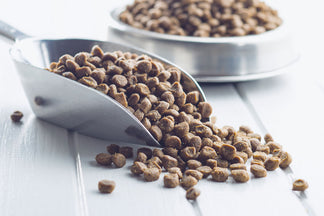Overview of a Pet Food Proteins
Dogs and cats are carnivores, which means that they are meant to eat a diet high in protein. However, when it comes to pet food, all protein sources are not created equal. This means that you can’t simply look at the total protein in a food and instead, must examine both the total protein and the source of protein in your pet’s food. Here are some quick rules of thumb to help you evaluate the protein that you are feeding your pet.
1. Animal or fish protein first.
Foods that are high in the right kinds of protein will have recipes that prioritize meats and fish as the first ingredients. Thus, look for a meat or fish source as the first item in the list.
2. Real, named meat or fish.
If a food brand can’t be specific as to the type of protein that is included in the recipe, than it is not good enough for your pet. Choose named sources like turkey, or beef instead of vague sources like poultry or meat. Avoid byproducts as well since they are unspecified parts of the animal and might contain low digestible ingredients or come from a rendering process.
3. Less processed proteins are better.
When in doubt, choose whole foods instead of processed ones. This means that actual meats and fish are better (and more natural) than meals. Although meals (e.g. chicken meal) are a concentrated source of protein and are used in many recipes, they are processed and shouldn’t form the foundation of your pet’s food. Choose salmon and duck instead of salmon meal and duck meal.
4. Lookout for non-meat protein sources.
Many pet food manufacturers will use cheaper, plant based proteins to up the protein in a recipe. Even though a real named meat might be the first ingredient, watch for grains, many of which contain protein, that are high on the ingredient list. For example, avoid foods with soy, wheat, or corn. Other tricks that are used to amp the protein amount is to include ingredients like pea protein or potato protein. These are inferior protein sources for a pet.
5. Calculate the protein percentage.
Now that you have used the first four rules to whittle down your choices, you can start to compare foods on a ‘dry matter basis’, in order to determine the protein, fat, and carbohydrate breakdown of a pet food. This calculation will be explained in an upcoming post so in the meantime, you can use the Petnet app which does the math for you. The bottom line is that you should look for foods that are lower in carbs, and thus higher in protein or fat. In the wild, dogs and cats would likely eat less than 15% carbohydrates, and 50% or more protein and the remainder in fats. While this might not be practical in today’s world, an easy benchmark is that for dry dog foods, the sum of the protein and fat percentages should be 45% or higher. For dry cat foods, this number should be 55% or higher.

 Food
Food
 Food
Food
 Food
Food
